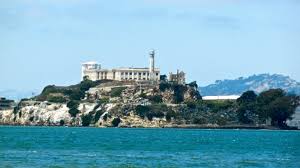Tribal Government & News
Grand Ronde sending contingent to Alcatraz activities

By Dean Rhodes
Smoke Signals editor
The Confederated Tribes of Grand Ronde is sending approximately 10 Tribal members to help commemorate the 50th anniversary of Native American activists taking over the island of Alcatraz in San Francisco Bay for 19 months.
Cultural Resources Cultural Advisor Bobby Mercier will lead the delegation, which will take part in festivities at Aquatic Park, which is near Pier 40 that was used a half-century ago to shuttle supplies and visitors over to the occupied island. The Tribe is not taking a canoe because of the strong currents and crowded sailing conditions in San Francisco Bay.
Mercier said a flotilla of Native American canoes from up and down the West Coast will be paddling around Alcatraz on Oct. 14 – Indigenous Peoples’ Day – and more events will be held in the nearby Indigenous Peoples’ Day Music and Arts Festival being held at Yerba Buena Gardens. The Grand Ronde delegation will perform protocol singing and dancing, as well as deliver a short speech.
The event is being sponsored by the Alcatraz Canoe Journey organizing committee, the Bay Area Indigenous community and International Indian Treaty Council.
The Grand Ronde delegation will be mostly comprised of staff members because of the tight timelines occurring in the park.
“It will show our connection to place and the history that we have with that place,” Mercier said. “And support the people that are there.”
When an October 1969 fire destroyed San Francisco’s American Indian Center, an activist group known as Indians of All Tribes targeted the unused land of Alcatraz, which had closed as a federal prison in 1963. A handful of protestors first journeyed to the island on Nov. 9 under the leadership of Mohawk college student Richard Oakes. They stayed only one night before authorities removed them.
Indians of All Tribes then seized Alcatraz in the early morning of Nov. 20 with an occupation force of 89 men, women and children. They sailed through San Francisco Bay under cover of darkness and landed on the island, claiming it for all North American Tribes.
Among those who participated in the occupation were Grand Ronde Tribal members Beryle Contreras, who walked on in May 2017.
In their first proclamation, the occupation force stated their intentions were to use the island for an Indian school, cultural center and museum.
The Nixon administration opted not to attempt to remove the Native Americans by force, fearing the bad publicity that would occur.
During the 19-month occupation, Native American college students and activists flocked to the protest and the population on the island grew to more than 600 people. Celebrities, including actors Anthony Quinn and Jane Fonda, visited and lent their support. Rock band Creedence Clearwater Revival even gave occupiers a boat, which was christened “Clearwater.”
However, by early 1970, the occupation started to fizzle as many of the college students and organizers had to return to school. Tragically, Oakes’ young stepdaughter fell to her death from one of the prison stairwells in January 1970, and he and his wife left, leaving warring activists to fight for control of the island.
Citing a need to restore the island’s foghorn and lighthouse, armed federal marshals ended the occupation in June 1971 and moved the last of the Native American residents, which had dwindled to only six men, five women and four children.
The 19-month occupation, however, was credited with galvanizing Native American activitists and rights organizations and federal officials started listening to calls for Native self-determination. The U.S. government later returned millions of acres of ancestral land and passed more than 50 laws supporting Tribal self-rule.
Mercier said the Grand Ronde Tribe’s connection to Alcatraz dates back to the 1850s when Athabaskan Chief ‘Tecumtum and his son, Adam, were arrested on the Siletz Indian Reservation for allegedly threatening the Indian agent.
They were sent to a U.S. Army jail at Fort Vancouver and then sent to San Francisco to be held at the Presidio. They were possibly detained and processed at Alcatraz and then permanently moved to the Presidio across the bay.
The island was sold to the U.S. government in 1849 and became home to the U.S. Army in 1859. By 1861, it was holding Tribal members from throughout the western territories and states.
“They just scraped it and built a prison on top of one of their old burial sites that they had out there in the middle of the water, which they have done here to us,” Mercier said about the cultural importance of Alcatraz, which was originally called Isla de los Alcatraces (Isle of the Pelicans). “For the people that were there, they were trying to get back one of their sacred places. … I just know that a lot of our people just happened to be there at that time.”
